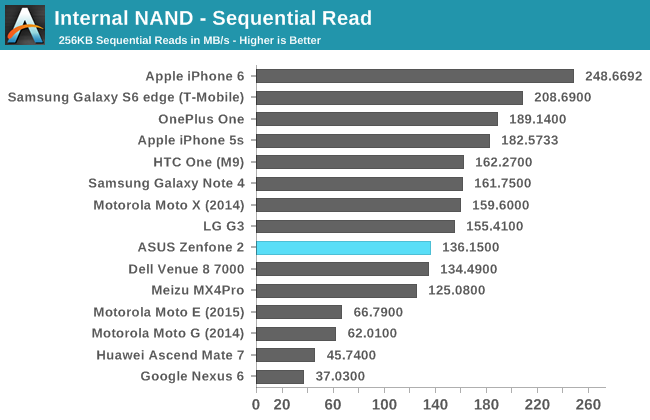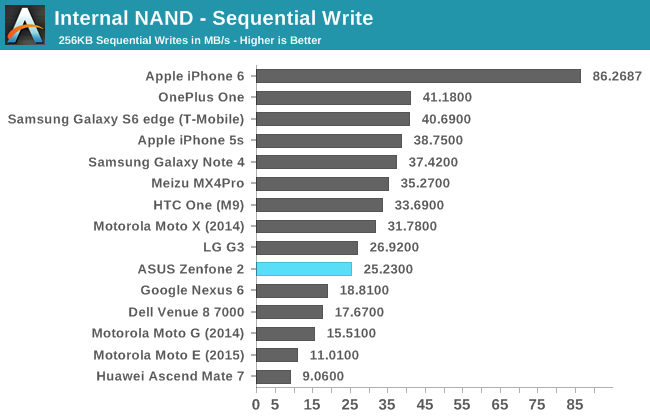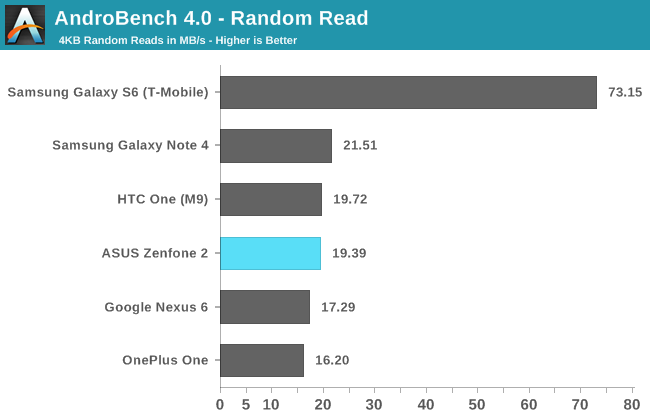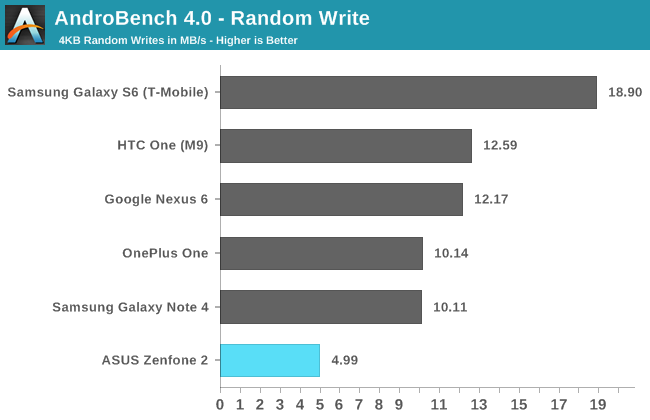The ASUS ZenFone 2 Review
by Brandon Chester on May 26, 2015 8:00 AM ESTNAND Performance
While it's not disclosed by manufacturers, the speed of NAND on a smartphone is a very important aspect of overall smartphone performance. It has an impact on how long cameras can do burst capture, and how well the phone performs when apps are running both in the foreground and the background. To evaluate the NAND performance of the ZenFone 2 I've run it through both of our internal storage benchmarks. Because our iOS benchmark only supports a single IO thread, we'll be using our older storage benchmark alongside the newer Androbench 4.0 test for the foreseeable future.




In our original single threaded storage benchmark the ZenFone 2 is decidedly average in its performance. In every case it's either slightly above or below the median result on our charts. It's important to keep in mind that this test puts devices like the Galaxy S6 with its UFS storage at a disadvantage, as its NAND can make use of several IO threads due to the use of a command queue.




In our newer AndroBench 4.0 storage test we see that the ZenFone 2 ends up falling farther behind the other devices that we've run through the test. In the sequential read test it's not the slowest device, but that's only due to the Nexus 6 being extremely far behind every other device as a result of Google's full disk encryption. In the sequential write and random read tests it's comes behind the HTC One (M9), although to a very small degree in the latter test. Random writes are where it really stumbles, with a speed that's less than half of the next slowest device.
I'm not sure whether I can attribute it to the enormous amount of RAM that the 4GB version of the ZenFone 2 can use as a cache, but I never noticed any issues with performance as a result of IO operations being run either by the app I was using or by another application in the background. Even when updating applications, performance remained consistent.










147 Comments
View All Comments
Brandon Chester - Tuesday, May 26, 2015 - link
Google Chrome is used for all of our browser tests, including battery life.re2onance - Tuesday, May 26, 2015 - link
I remember watching a review earlier about the screen being low in brightness. I thought it may have been on purpose although I assumed it was due to Asus trying to make up for the Intel SoC power consumption.I've read in the XDA forums that people experience better battery life after rooting and removing a lot of the bloatware apps, particularly the Asus built-in web browser that seems to be attached to the Trend Micro security. Honestly, people shouldn't have to root their device in order to eek out better battery life.
It seems kinda weird how Asus would spend the effort to gimp the screen from what it is actually capable of, and then fill it with apps which probably also could hinder battery life as well.
It seems like a good value phone, but the direction is all over the place.
I think the review seems fair since this is both the hardware and software Asus shipped with and updated.
T1beriu - Tuesday, May 26, 2015 - link
Brandon, could you actually disable all ASUS bloatware?I got an ASUS MeMO Pad 7 (ME572C) updated to 5.0 that looks exactly as your screenshots and I can't disable any of the useless ASUS apps.
Shame on you ASUS.
Brandon Chester - Tuesday, May 26, 2015 - link
No you can't disable all of it. I probably should have been more specific about that. You can uninstall or disable some apps such as the Apps4U apps and a few others like Omlet chat. Most of the apps that are actually from ASUS are stuck there though.ketacdx - Tuesday, May 26, 2015 - link
Hey Brandon. I thought the same but if you follow the method of holding the app in the app menu and drag it to uninstall at the top, that seems to work for most. For some reason I wasn't able to uninstall in Google Play for the same ones oddly, only disable.Brandon Chester - Wednesday, May 27, 2015 - link
That isn't working for me for apps like ZenCircle, Mirror, etc. The button to disable is greyed out.ketacdx - Thursday, May 28, 2015 - link
Yeah, I cant get those off either but it worked a lot of them thankfully. I really wish they enabled uninstall for the rest...tipoo - Tuesday, May 26, 2015 - link
"In the case of the ZenFone 2, we see that it lasts exactly as long as the HTC One (M9). Last run GPU performance is noticeably slower though."But isn't that just the relative performance difference between the two GPUs? I guess I still don't really understand the last run GPU framerate metric, shouldn't it be as a proportion of the first run framerate to mean anything? If one device performs at 100, another performs at 50, and the final runs of both are 50, the final run FPS would appear the same, but the second device didn't throttle at all while the first throttled by half.
Does the test already take this into account?
SHartman1976 - Tuesday, May 26, 2015 - link
I think you guys need to rerun the Nexus 6 battery benchmarks with 5.1 - the experience of myself and many others regarding N6 battery life is nothing like what you found on the initial 5.0 review.Brandon Chester - Wednesday, May 27, 2015 - link
I just finished re-testing the Nexus 6 on 5.1 and it lasted for 7 hours and 24 minutes in our browser test which is a worse result than the initial review. It's a small enough difference that I'll attribute it to battery degradation and/or test variance, but the point is that it hasn't improved at all.